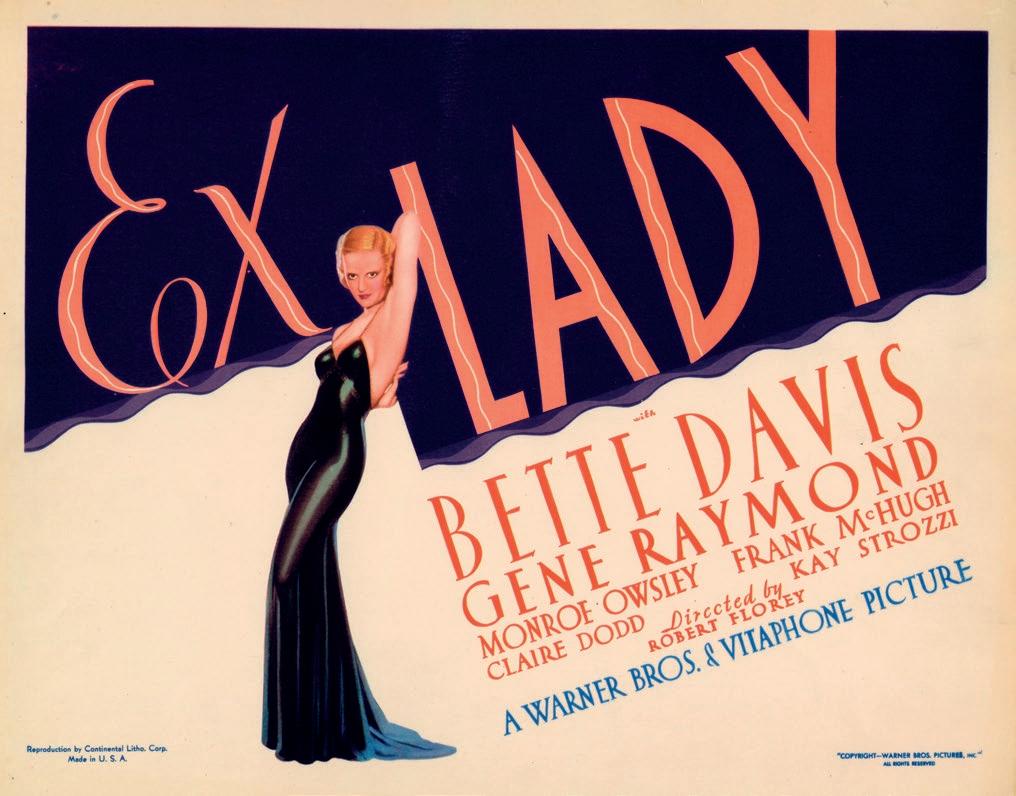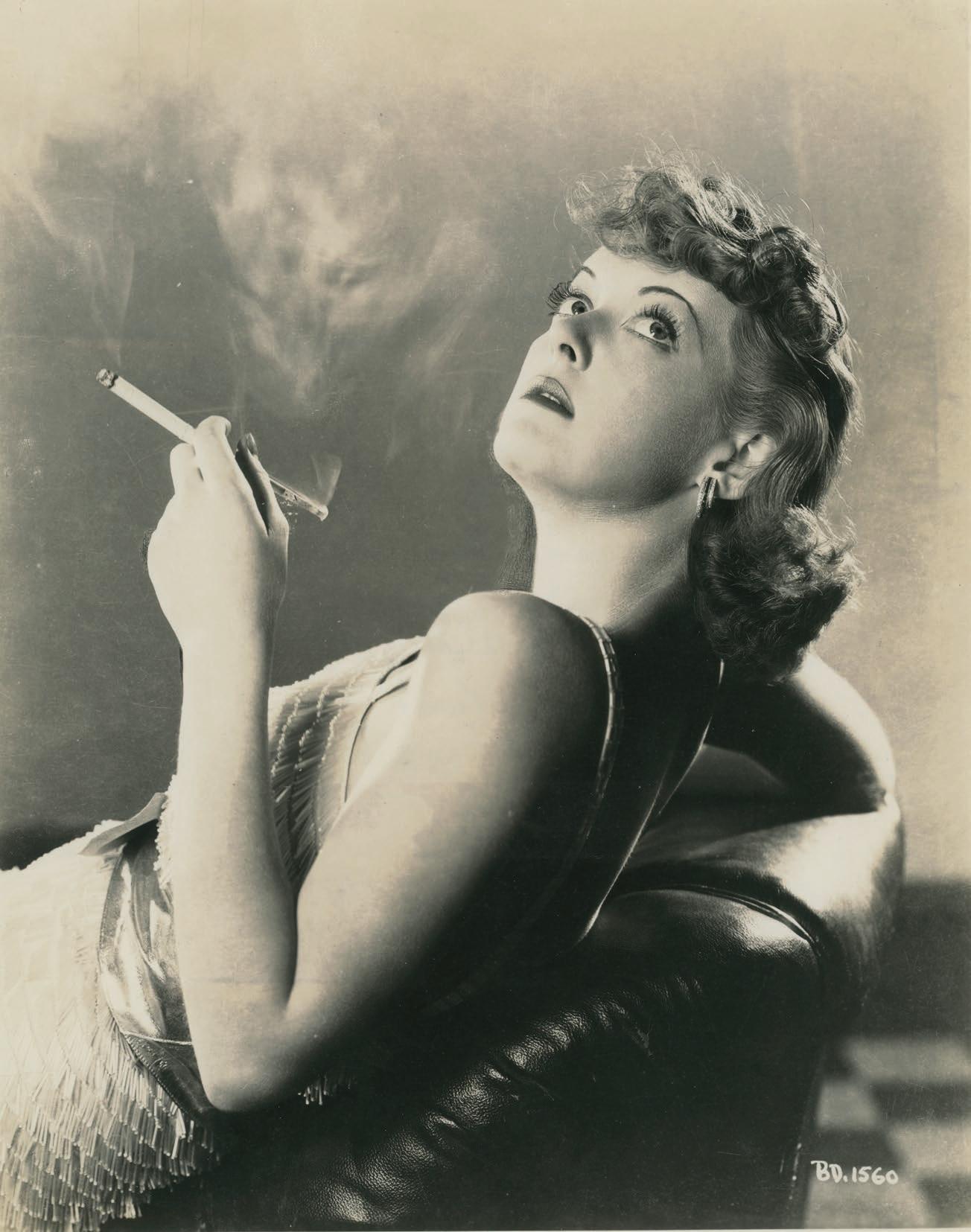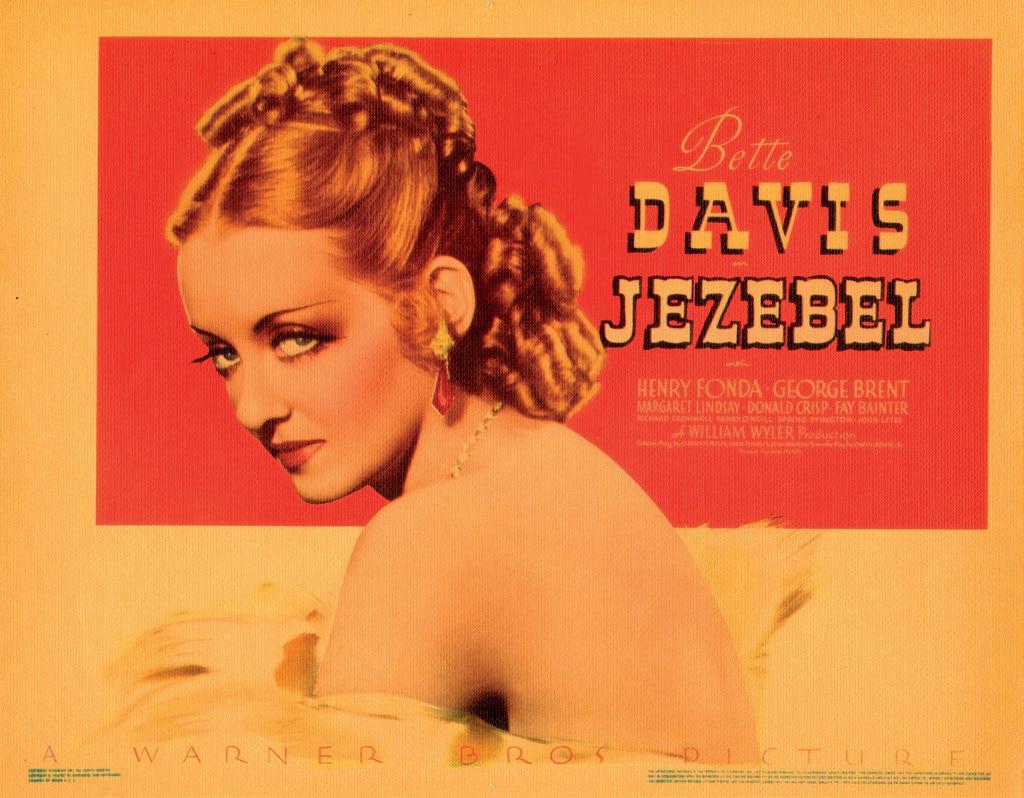






WThe intensity of Bette Davis’ gaze in this promotional photo for Satan Met A Lady (1936, Warner Bros., dir. William Dieterle) portends the courage of conviction with which she would forge a legendary, lasting career.
(1908–1989)
idely regarded as one of Hollywood’s greatest actresses, Bette Davis had a monumental career that spanned over five decades, one hundred films, and numerous genres. The so-called “First Lady of the American Screen,” she was the first person to garner a record ten Academy Award acting nominations. She possessed a talent for playing tempestuous, strong-willed women—and did so with exhilarating depth and complexity. Instantly recognizable for her expressive eyes, idiosyncratic diction, and distinctive mannerisms, Davis was known to punctuate each gesture with the emphatic flick of an ever-present cigarette. She famously eschewed the glamor of movie stardom and was unafraid to take on roles that made her appear unattractive or dislikable. Her acting prowess was only matched by her professional tenacity, which earned her a reputation for being forthright and demanding—evidence of the unrelenting ambition that powered her legendary career.
Born in Lowell, Massachusetts, on April 5, 1908, Ruth Elizabeth “Bette” Davis made her grand entrance as a bolt of lightning struck a nearby tree at the moment of her birth. After her parents divorced in 1915, she was raised by her mother, who encouraged her pursuit of acting and moved the family to New York City. She made her stage debut at the age of 20 and took her first Broadway bow the following year. Soon after, she caught the eye of a talent scout who invited her to Hollywood for a screen test, and by 1930, she had signed with Universal.
From her arrival in Hollywood, it was clear that Bette Davis would not fit the mold of a traditional starlet. Her film debut in the pre-code drama Bad Sister (1931) was followed by several lackluster films, and ultimately, the studio chose
not to renew her contract due to a purported lack of sex appeal. When Davis signed with Warner Brothers in 1932, she embarked on a career-defining relationship with the studio, though one with an inauspicious start.
At first, she was styled in the likes of the charming blonde ingénue à la Constance Bennett, and her early roles saw her miscast in conventional models of cinematic femininity. She played variations on the gangster moll archetype in 20,000 Years in Sing Sing (1932) and Parachute Jumper (1933), before getting the full Hollywood glamor girl treatment in films like Ex-Lady (1933) and Fashions of 1934 (1934)—complete with platinum locks, false eyelashes, and figurehugging gowns. She remained, however, indifferent toward the glitzy trappings that brought fame to other actresses at the time, claiming, “I knew it was possible with my ambitions for acting rather than for glamour that I might never equal their popularity. But I was I!”
Indeed, it was a loan-out to RKO that would bring Davis her breakout role— one that was decidedly unglamorous, and served to showcase her acting ability. In Of Human Bondage (1934), she played Mildred Rogers, a disdainful waitress who becomes the ruinous object of a man’s obsession and eventually succumbs to a tawdry life of prostitution. So committed was she to the portrayal of Mildred’s downfall, that Davis insisted on doing her own makeup for the final scene, claiming, “The last stages of consumption, poverty, and neglect are not pretty and I [intend] to be convincing-looking.” Her impassioned display of contempt and vulgarity in the film was lauded by critics and audiences alike—which made her omission from the Best Actress category one of the greatest scandals in Academy Award history.
The following year, she won the Oscar for the comparatively inferior Dangerous (1935), in which she played a down-and-out actress with destructive tendencies. Though it is generally agreed that the award was a consolation for the Academy’s oversight the prior year, the win established her virtuosity for playing complicated, unsympathetic characters.
Davis’ initial triumph was followed by a period of conflict at Warner Brothers. She demanded a salary increase commensurate with her critical acclaim and repeatedly turned down inconsequential roles that she thought were beneath her. When placed on suspension for refusal to work, she attempted to seek better parts abroad, only to be sued by the studio for breach of contract in 1936. During the trial, Davis was treated unfavorably by the press and was portrayed as a spoiled brat and “unemployed movie star.” She nevertheless held firm in her conviction and asserted her claim, later stating, “I knew that, if I continued to appear in any more mediocre pictures, I would have no career worth fighting for.” Although she ended up losing the legal case against Warner Brothers, her bold display of moxie earned her newfound respect upon her return to the studio lot—which ultimately led to the substantial roles and increased pay she had been fighting for. When looking back on this pivotal moment in her career, Davis confessed, “In a way, my defeat was a victory. [...] In the long view, there is no question but that I won after all.”
Bette Davis—along with every other actress in Hollywood—vied for the chance to play Scarlett O’Hara in the highly anticipated adaptation of Gone with the Wind
(1939). She didn’t get the part, but Warner Brothers beat the film to the box office with their own period drama. In Jezebel (1938), Davis played Julie Marsden, a headstrong antebellum Southern Belle who brazenly wears a red dress to a ball where unmarried young ladies were expected to appear in virginal white. It was a commanding performance that brought her a second Oscar win and marked the beginning of the most successful phase of her career at Warner Brothers.
During this period, Davis became the studio’s highest-earning star and was fittingly nicknamed “the fifth Warner Brother.” She shined as a modern heroine in films like Dark Victory (1939), in which she played a carefree, young socialite who reconsiders her lifestyle after receiving a terminal diagnosis. In Now, Voyager (1942), her character Charlotte Vale transforms from the dowdy, timid daughter of a domineering Boston dowager to a self-assured, independent woman with an elegant wardrobe to match. Davis also excelled at playing temperamental women in corsets, in period dramas like The Little Foxes (1940) and historical biopics like The Private Lives of Elizabeth and Essex (1939). She would reprise her portrayal of Queen Elizabeth I in The Virgin Queen (1955), but only after a series of professional setbacks resulting in the end of her long tenure at Warner Brothers in 1949.
Bette Davis reached the apex of her career with All About Eve (1950), in a role that would define her legacy. As the anti-heroine Margo Channing—a Broadway star whose ambitious young protégé attempts to take over her career and love life—Davis came into her full grandeur. She delivered a pyrotechnic display of acerbic quips and downed martinis, with nostrils flared and eyes ablaze, in the quintessential performance in the “aging actress” genre—delivered with all the gravitas and technical bravura of a seasoned screen veteran. Though her comeback was short-lived, Davis reinvented herself yet again in the 1960s and found renewed success with horror films like Whatever Happened to Baby Jane? (1962) and Hush…Hush, Sweet Charlotte (1964).
Upon reflection of her life’s work, Bette Davis expressed, “The cornerstone of my career in films was the power for action with which all women identified.” Indeed, the many characters she brought to life demonstrate a range and depth of the female experience in all of its over-the-top, messy glory. Over the course of almost 60 years, she weathered the vicissitudes of a long career in Hollywood with sheer tenacity—her epitaph providing the perfect summation of her perseverance: “She did it the hard way.”


Clad in a skin-tight black gown, Davis is given the glamor treatment in this lobby card for the pre-Code film Ex-Lady (1933, Warner Bros., dir. Robert Florey). The illustration exaggerates her features in a mistaken attempt to cast her as a sex symbol.
below
In Of Human Bondage (1934, RKO Pictures, dir. John Cromwell), Davis stars opposite Leslie Howard in a role that would redefine her on-screen persona and ultimately lead her to her first Academy Award.
opposite
In perhaps one of the earliest promotional photos of Bette Davis distributed by Warner Brothers, c. 1932, it is evident that studio executives styled her in the guise of Constance Bennett, who was one of the highest paid actresses in Hollywood during the early 1930s.



Bette Davis’ direct gaze captures her character’s contempt in the lobby card for Dangerous (1935, Warner Bros., dir. Alfred E. Green). In the lobby card for Marked Woman (1937, Warner Bros., dir. Lloyd Bacon), her visage is further intensified by the graphic quality of the design, which draws focus to her piercing eyes and tempestuous pout.
opposite
In this publicity photo for Marked Woman (1937, Warner Bros., dir. Lloyd Bacon), Davis is framed by the smoke from a lit cigarette—an accessory that would become integral to her image.




Adorned in a scarlet ball gown designed by Orry-Kelly, Davis delivered a fiery performance in Jezebel (1938, Warner Bros., dir. William Wyler) that earned her a second Academy Award for Best Actress. Seen here are a lobby card and wardrobe test for the movie.
opposite
The self-assuredness with which Bette Davis is captured in this 1936 studio portrait speaks to her resolve in taking on the studio executives in a landmark legal case. Despite her loss, she would return to Warner Brothers with newfound vigor.



In her most definitive role, Bette Davis led an all-star cast that included Anne Baxter, Marilyn Monroe, and George Saunders—featured in this lobby card for All About Eve (1950, 20th Century Fox, dir. Joseph Mankiewicz).